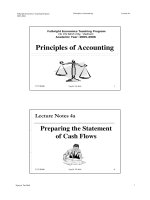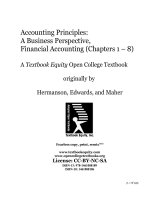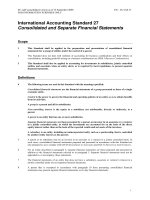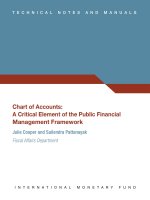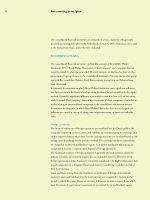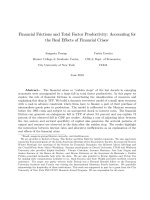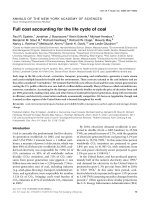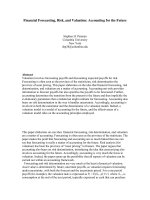Accounting principles: The consolidated financial ... potx
Bạn đang xem bản rút gọn của tài liệu. Xem và tải ngay bản đầy đủ của tài liệu tại đây (645.52 KB, 75 trang )
Accounting principles
The consolidated financial statements are prepared on a basis consistent with generally
accepted accounting principles in the Netherlands (‘Dutch GAAP’). Historical cost is used
as the measurement basis unless otherwise indicated.
Consolidation principles
The consolidated financial statements include the accounts of Koninklijke Philips
Electronics N.V. (‘Royal Philips Electronics’ or ‘the Company’) and companies that are
majority-owned or otherwise controlled. Minority interests are disclosed as share of other
group equity in group income in the consolidated statement of income and as other group
equity in the consolidated balance sheet. Intercompany transactions and balances have
been eliminated.
Investments in companies in which Royal Philips Electronics exerts significant influence,
but does not control the financial and operating decisions, are accounted for by the equity
method. Generally, significant influence is presumed to exist if at least 20% of the voting
stock is owned. The Company’s share of the net income of these companies is included in
results relating to unconsolidated companies in the consolidated statement of income.
Investments in companies in which Royal Philips Electronics does not exert significant
influence are carried at cost or, if a long-term impairment exists, at lower net realizable
value.
Foreign currencies
The financial statements of foreign operations are translated into the Dutch guilder, the
Company’s reporting currency. Assets and liabilities are translated using the exchange rates
on the respective balance sheet dates. Income and expense items are translated based on the
average rates of exchange for the periods involved. The resulting translation adjustments
are charged or credited to stockholders’ equity. Cumulative translation adjustments are
recognized as income or expense upon disposal of foreign operations.
The functional currency of foreign operations is generally the local currency, unless the
primary economic environment requires the use of another currency. However, when
foreign operations conduct business in economies considered to be highly inflationary, they
record transactions in a designated functional currency (usually the dollar) instead of
their local currency.
Gains and losses arising from the translation or settlement of foreign-denominated
monetary assets and liabilities into the local currency are recognized in income in the
period in which they arise. However, currency differences on intercompany loans which
have the nature of a permanent investment are accounted for in stockholders’ equity.
72
Derivative financial instruments
The Company uses derivative financial instruments principally in the management of its
foreign currency risks. A derivative financial instrument is recognized by the Company on
its balance sheet at the value of the consideration given or received for it. After initial
recognition the Company measures derivatives at their fair value. Gains or losses arising
from changes in the fair value of a derivative are recognized in the income statement for the
period in which they arise to the extent they hedge an asset or liability that has been
recognized on the balance sheet. Unrealized gains and losses relating to derivative financial
instruments entered into as hedges of firm commitments are deferred until the hedged
transactions have been reflected in the accounts. Deferred gains and losses on hedges of
firm commitments are reported in the balance sheet as deferred income under stockholders’
equity.
Cash and cash equivalents
Cash and cash equivalents include all cash balances and short-term highly liquid
investments that are readily convertible to known amounts of cash. They are stated at face
value.
Receivables
Receivables are carried at face value, net of allowances for doubtful accounts.
Inventories
Inventories are valued at the lower of cost or market value less advance payments on work
in process. The cost of inventories comprises all costs of purchase, costs of conversion and
other costs incurred bringing the inventories to their present location and condition. The
costs of conversion of inventories include direct labor, fixed and variable production
overheads, product development and process development costs, taking into account the
stage of completion. The cost of inventories is determined using the first-in, first-out
(FIFO) method. Provision is made for obsolescence.
Other non-current assets
Loans receivable are carried at face value, less a provision for doubtful accounts.
Investments in companies (securities) with a restriction on the resale of these securities for a
period of one year or more, are accounted for at cost, being the fair value upon receipt of
the shares. These are presented as other non-current financial assets.
73
Property, plant and equipment
Property, plant and equipment is carried at cost less accumulated depreciation. Assets
manufactured by the Company include direct manufacturing costs, production overheads
and interest charges incurred during the construction period. Government grants are
deducted from the cost of the related asset. Depreciation is calculated using the
straight-line method over the expected economic life of the asset. Depreciation of special
tooling costs is based on the expected future economic benefit of these tools. In the event
that an impairment in value of fixed assets occurs, the loss is charged to income. Gains and
losses on the sale of property, plant and equipment are included in other business income.
Intangible assets
Intangible assets include goodwill arising from acquisitions made after January 1, 1992.
Goodwill is amortized using the straight-line method over its estimated economic life, not
to exceed forty years.
Certain acquired intangible assets other than goodwill (‘in-process R&D’) are expensed in
the period of acquisition.
Patents and trademarks acquired from third parties are capitalized and amortized over their
remaining lifetime.
If events or circumstances indicate that the carrying amount of intangible assets may not be
recoverable, an impairment test is applied based upon an assessment of future cash flows to
ensure that they are appropriately valued.
Costs of research and development are expensed in the period in which they are incurred.
Provisions
Provisions are recognized by the Company for liabilities and losses which have been
incurred as of the balance sheet date and for which the amount is uncertain but can be
reasonably estimated. Additionally, the Company records provisions for losses which are
expected to be incurred in the future but which relate to contingencies that exist as of the
balance sheet date.
Provisions are stated at face value, with the exception of provisions for postretirement
benefits (including pensions) and severance payments in certain countries where such
payments are made in lieu of pension benefits; those provisions are stated at the present
value of the future obligations.
74
Debt and other liabilities
Debt and liabilities other than provisions are stated at face value.
Revenue recognition
Sales are generally recognized at the time the product is delivered to the customer, net of
sales taxes, customer discounts, rebates and similar charges. Service revenue is recognized
over the contractual period or as services are rendered. Revenues from long-term contracts
are recognized in accordance with the percentage of completion method. Provision for
estimated contract losses, if any, is made in the period that such losses are determined.
Royalty income is recognized on an accrual basis. Government grants other than those
relating to assets, are recognized as income to the extent that it is more likely than not that
these grants will be received.
Financial income and expenses
Interest income and interest expense are recognized on an accrual basis.
Income taxes
Income tax expense is based on pre-tax financial accounting income. Deferred tax assets
and liabilities are recognized for the expected tax consequences of temporary differences
between the tax bases of assets and liabilities and their reported amounts. Measurement of
deferred tax assets and liabilities is based upon the enacted tax rates expected to apply to
taxable income in the years in which those temporary differences are expected to be
recovered or settled. Deferred tax assets, including assets arising from loss carryforwards,
are recognized if it is more likely than not that the asset will be realized. Deferred tax assets
and liabilities are not discounted. Deferred tax liabilities for withholding taxes are only
taken into consideration in situations where the income of subsidiaries is to be paid out as
dividends in the near future.
75
Benefit accounting
The Company accounts for the cost of pension plans and postretirement benefits other
than pensions substantially in accordance with SFAS No. 87 ‘Employers Accounting for
Pensions’ and SFAS No. 106 ‘Postretirement Benefits other than Pensions’, respectively.
Most of the Company’s defined benefit plans are funded with plan assets that have been
segregated and restricted in a trust to provide for the pension benefits to which the
Company has committed itself. When plan assets have not been segregated by the
Company or in such cases in which the Company is required to make additional pension
payments, the Company recognizes a provision for such amounts. The costs related to
defined benefit pension plans are in general terms the aggregate of the compensation cost
of the benefits promised, interest cost resulting from deferred payment of those benefits
and, in the case of plan assets segregated in a trust, the results on the amounts of the
invested plan assets. The cost component of the pension benefit corresponding to each year
of service is the actuarial present value of the benefit earned in that year. In principle the
same amount of pension benefit is attributed to each year of service. If and to the extent
that as of the beginning of the year, the present value of the projected benefit obligation
differs from the market value of the plan assets or the existing pension provision, the
difference is amortized over the average remaining service period of active employees. In
the event, however, that at any date the accumulated benefit obligation calculated as the
present value of the benefits attributed to employee service rendered prior to that date and
based on current and past compensation levels would be higher than the market value of
the plan assets or the existing level of the pension provision, the difference is immediately
charged to income.
In certain countries the Company also provides postretirement benefits other than
pensions to various employees. The cost relating to such plans consists of the present value
of the benefits attributed on equal basis to each year of service, and interest cost on the
accumulated postretirement benefit obligation, which is a discounted amount. The
transition obligation is being recognized through charges to earnings over a twenty-year
period beginning in 1993 in the and in 1995 for all other plans.
Stock-based compensation
The Company accounts for stock-based compensation using the intrinsic value method in
accordance with Dutch GAAP which is also in conformity with US Accounting Principles
Board Opinion No. 25, ‘Accounting for Stock Issued to Employees’. The Company has
adopted the pro forma disclosure requirements of SFAS No. 123, ‘Accounting for
Stock-Based Compensation’.
Discontinued operations
Any gain or loss from disposal of a segment of a business (product sector), together with
the results of these operations until the date of disposal, are reported separately as
discontinued operations. The financial information of a discontinued segment of business
is excluded from the respective captions in the consolidated financial statements and related
notes. Comparative figures for prior periods are restated accordingly.
76
Extraordinary income and losses
Extraordinary items include income or losses arising from the disposal of a line of activity
or closures of substantial production facilities within a segment of business as well as
significant gains or losses arising from disposals of interests in unconsolidated companies.
Risks and uncertainties
The preparation of financial statements requires management to make estimates and
assumptions that affect amounts reported in the consolidated financial statements in order
to conform with generally accepted accounting principles. Changes in such estimates and
assumptions may affect amounts reported in future periods.
Cash flow statements
Cash flow statements have been prepared under the indirect method in accordance with
Dutch GAAP, which is substantially similar to the requirements of SFAS No. 95
‘Statement of Cash flows’. Cash flows in foreign currencies have been translated into
Dutch guilders using the average rates of exchange for the periods involved.
77
Consolidated statements of income of the Philips Group
in millions of Dutch guilders unless otherwise stated
1998 1997* 1996*
Sales 67,122 65,358 59,707
Direct cost of sales (53,155
) (50,780) (47,574)
Gross income 13,967 14,578 12,133
Selling expenses (9,655) (8,950) (9,195)
General and administrative expenses (2,495) (2,036) (1,774)
Other business income 418 290 330
Restructuring charges (726
) (105) (565)
L
2
Income from operations 1,509 3,777 929
L
3
Financial income and expenses (686) (703) (890)
Income before taxes 823 3,074 39
L
4
Income taxes (91) (607)15
Income after taxes 732 2,467 54
L
5
Results relating to unconsolidated companies 86 206 320
Group income 818 2,673 374
L
6
Share of other group equity in group income 374 39 (96)
Income from continuing operations 1,192 2,712 278
L
1
Discontinued operations:
Income from discontinued operations
(less applicable income taxes of NLG 166, NLG 355 and NLG 244 million
for 1998, 1997 and 1996, respectively) 462 579 445
Gain on disposal of discontinued operations
(no tax effect) 10,675 ––
L
7
Extraordinary items – net 1,010 2,442 (1,313)
L
8
Net income (loss) 13,339 5,733 (590)
78
Earnings per share
1998 1997* 1996*
Weighted average number of common shares outstanding
(after deduction of treasury stock) during the year 360,056,076 349,397,603 341,847,784
Basic earnings per common share in NLG:
- income from continuing operations 3.31 7.76 0.81
- income from discontinued operations 1.28 1.66 1.30
- gain on disposal of discontinued operations 29.65 ––
- extraordinary items – net 2.81 6.99 (3.84)
- net income (loss) 37.05 16.41 (1.73)
Diluted earnings per common share in NLG:
- income from continuing operations 3.29 7.61 0.81
- income from discontinued operations 1.27 1.63 1.30
- gain on sale of discontinued operations 29.41 ––
- extraordinary items – net 2.78 6.85 (3.84)
- net income (loss) 36.75 16.09 (1.73)
Dividend per common share in NLG 2.20** 2.00 1.60
The dilution effects on earnings per share are only taken into consideration if this does not result in an improvement
in income per share or in a reduction in loss per share (year 1996).
* Restated to reflect the sale of PolyGram N.V. and to present the Philips Group accounts on a continuing basis for all
years presented.
** Subject to approval by the Annual General Meeting of Shareholders on March 25, 1999.
79
Consolidated balance sheets of the Philips Group
as of December 31
in millions of Dutch guilders unless otherwise stated
The 1998 consolidated balance sheet includes a liability for the proposed dividend, which is subject to approval by the
Annual General Meeting of Shareholders on March 25, 1999.
Assets
1998 1997*
Current assets
L
9
Cash and cash equivalents 14,441 3,079
L
10
Receivables:
- Accounts receivable, net 9,566 10,399
- Other receivables 1,681 1,197
- Prepaid expenses 745
444
11,992 12,040
L
11
Inventories 9,419 9,966
Total current assets 35,852 25,085
Non-current assets
L
5
Unconsolidated companies:
- Investments 2,104 2,469
- Loans 45 55
- Net assets of discontinued operations (PolyGram N.V.) – 3,265
2,149 5,789
L
12
Other non-current financial assets 4,101 674
L
13
Non-current receivables:
- Accounts receivable 630 176
- Other receivables 454 366
- Prepaid expenses 3,146 3,553
4,230 4,095
L
14
Property, plant and equipment:
- At cost 36,741 37,161
- Less: accumulated depreciation (22,253
) (21,878)
14,488 15,283
L
15
Intangible assets 1,221 468
Total non-current assets 26,189 26,309
Total 62,041 51,394
* Restated to reflect the sale of PolyGram N.V. and to present the Philips Group accounts on a continuing basis for all
years presented.
80
Liabilities and stockholders’ equity
1998 1997*
Current liabilities
Accounts and notes payable:
- Trade creditors 6,469 6,333
- Unconsolidated companies 27
67
6,496 6,400
L
16
Accrued liabilities 6,396 6,078
L
17
Short-term provisions 2,128 2,066
L
18
Other current liabilities 2,047 1,465
Dividend payable 794 716
L
19
Short-term debt 1,765 1,810
Total current liabilities 19,626 18,535
Non-current liabilities
L
20
Long-term debt 6,140 7,072
L
17
Long-term provisions 4,450 5,098
Total non-current liabilities 10,590 12,170
L
21
Commitments and contingent liabilities
Group equity
L
6
Other group equity 533 1,232
Stockholders’ equity:
Priority shares, par value NLG 5,000 per share:
Authorized and issued 10 shares
Preference shares, par value NLG 10 per share:
Authorized 499,995,000 shares
Issued – none –
Common shares, par value NLG 10 per share:
Authorized 500,000,000 shares
- Issued 368,494,824 shares
- (364,777,116 in 1997) 3,685 3,648
L
22
Share premium 4,019 3,943
L
22
Other reserves 23,588 11,866
31,292 19,457
Total 62,041 51,394
81
Consolidated statements of cash flows
of the Philips Group
in millions of Dutch guilders
1998 1997* 1996*
Cash flows from operating activities:
Net income (loss) 13,339 5,733 (590)
Adjustments to reconcile net income to net cash provided
by operating activities:
Income from discontinued operations (462) (579) (445)
Net gain on disposal of discontinued operations (10,675) ––
Depreciation and amortization 4,164 3,520 3,405
Net gain on sale of investments (1,604) (3,070) (255)
Decrease (increase) in working capital, net of effects from acquisitions and sales 600 1,137 (556)
Decrease (increase) in non-current receivables 95 (341) (390)
(Decrease) increase in provisions (390) (246) 833
Results relating to unconsolidated companies (68) – (283)
Share of other group equity in group income (382) (100) 24
Other items
98 1,019 265
Net cash provided by operating activities 4,715 7,073 2,008
Cash flows from investing activities:
Capital expenditures on property, plant and equipment (3,600) (3,585) (4,815)
Proceeds from disposals of property, plant and equipment 527 496 354
Purchase of other non-current financial assets (149) (383) (258)
Proceeds from other non-current financial assets 291 527 339
Purchase of businesses, net of cash acquired (1,910) (576) (794)
Proceeds from sale of interests in businesses
1,666 3,621 1,128
Net cash (used for) provided by investing activities (3,175) 100 (4,046)
Cash flows (before financing activities) 1,540 7,173 (2,038)
Cash flows from financing activities:
(Decrease) increase in short-term debt (164) (3,311) 1,478
Principal payments on long-term debt (1,245) (2,597) (1,855)
Proceeds from issuance of long-term debt 427 886 2,560
Payments of conversion certificates – (33) –
Effect of other financial transactions 252 ––
Treasury stock transactions (345) (251) 77
Dividends paid (719) (557) (549)
Net cash (used for) provided by financing activities (1,794) (5,863) 1,711
Cash (used for) provided by continuing operations (254) 1,310 (327)
* Restated to reflect the sale of PolyGram N.V. and to present the Philips Group accounts on a continuing basis for all
years presented.
82
Consolidated statements of cash flows of the Philips Group (continued)
1998 1997* 1996*
Cash (used for) provided by continuing operations (254) 1,310 (327)
Effect of changes in exchange rates and consolidations on cash positions 67 (89) (123)
Net cash provided by (used for) discontinued operations 202 407 (65)
Net cash from disposal of discontinued operations 11,347 ––
Cash and cash equivalents at beginning of year
3,079 2,145 2,660
Cash and cash equivalents at end of year 14,441 3,773 2,145
Of which: cash and cash equivalents discontinued operations
– 694 414
Cash and cash equivalents continuing operations 14,441 3,079 1,731
Supplemental disclosures to consolidated statements of cash flows:
Decrease (increase) in working capital net of effects
from acquisitions and sales:
Increase in accounts receivable and prepaid expenses (292) (56) (1,798)
(Increase) decrease in inventories (133) (394) 857
Increase in accounts payable and accrued expenses 1,025
1,587 385
600 1,137 (556)
Net cash paid during the year for:
Interest 536 748 767
Income taxes 440 340 313
Additional common stock issued upon conversion of long-term debt 56 143 8
Net gain on sale of investments:
Cash proceeds from the sale of investments (property, plant and equipment
and interests in companies) 2,492 4,644 1,827
Book value of these investments taking into account the effects of related
goodwill and translation differences (888
) (1,574) (1,572)
1,604 3,070 255
Non-cash investing and financing information:
Assets received in lieu of cash 3,742 82 –
Treasury stock transactions:
Shares acquired (711) (781) (217)
Shares sold 260 206 54
Exercise warrants/stock options 106 324 240
For a number of reasons, principally the effects of translation differences and consolidation changes, certain items in the
statements of cash flows do not correspond to the differences between the balance sheet amounts for the respective
items.
83
Consolidated statements of changes in stockholders’ equity
in millions of Dutch guilders, unless otherwise stated
number of shares * issued, share other total
paid-up premium reserves
outstanding issued capital
Balance as of December 31, 1995 341,756,174 345,062,054 3,451 3,474 7,130 14,055
Issued in exchange for:
- convertible debentures and on exercise
of conversion certificates 190,569 2 6 8
- stock options 1,422,330 14 29 43
- warrants 5,804,609 58 139 197
Net loss for the year (590) (590)
Dividend payable (555) (555)
Treasury stock transactions (163) (163)
Translation differences and other changes
961 961
Balance as of December 31, 1996 347,080,144 352,479,562 3,525 3,648 6,783 13,956
Issued in exchange for:
- convertible debentures and on exercise
of conversion certificates 1,544,714 15 79 94
- stock options (42) (42)
- warrants 10,752,840 108 258 366
Net income for the year 5,733 5,733
Dividend payable (716) (716)
Treasury stock transactions (493) (493)
Translation differences and other changes
559 559
Balance as of December 31, 1997 357,949,491 364,777,116 3,648 3,943 11,866 19,457
Issued in exchange for:
- convertible debentures and on exercise
of conversion certificates 80,847 1 6 49 56
- stock options (17) (17)
- warrants 3,636,861 36 87 123
Net income for the year 13,339 13,339
Dividend payable (794) (794)
Treasury stock transactions (451) (451)
Translation differences and other changes
(421) (421)
Balance as of December 31, 1998 360,690,217 368,494,824 3,685 4,019 23,588 31,292
* par value NLG 10 per share
84
Notes to the consolidated financial statements
of the Philips Group
all amounts in millions of Dutch guilders unless otherwise stated
Introduction
The financial statements of Koninklijke Philips Electronics N.V. (the ‘Parent Company’)
are included in the statements of the Philips Group. The unconsolidated statements of
income of Koninklijke Philips Electronics N.V. therefore reflect only the net after-tax
income from affiliated companies and other income after taxes.
The accompanying notes are an integral part of the consolidated financial statements.
Presentation balance sheet and income statement
In 1997, the Company changed the format of its consolidated balance sheet presentation.
The primary reason for the change was to accommodate the expectations of foreign, mainly
US shareholders, who represent a large percentage of the shareholders in the Company.
In light of this, the Company decided to present its consolidated balance sheet and income
statement more in line with a presentation that is common practice in the United States.
Under the new format, the order of presentation of assets and liabilities is based on the
degree of liquidity.
The most important change refers to certain items which in the previous format were
included in current receivables and have been reclassified to long-term receivables under
the new format, to better reflect the nature of the assets and to better present working
capital and the proportion of current assets that is not current. The current balance sheet
presentation is somewhat different from the one used under Dutch regulations.
L
1
Acquisitions and divestitures
PolyGram
On May 21, 1998, Philips, PolyGram N.V. (‘PolyGram’) and The Seagram Company Ltd.
(‘Seagram’) announced that they had reached an agreement that Seagram would acquire all
outstanding shares of PolyGram for a consideration of 117 in cash for each PolyGram
share or, at shareholders’ election, a mixture of cash and Seagram shares based on an
exchange ratio of 1.4012 Seagram shares for each PolyGram share. On June 22, 1998, the
price was reduced to 115 or a mixture of cash and Seagram shares based on an
exchange ratio of 1.3772 Seagram shares for each PolyGram share. This reduction reflected
the lower than expected financial results of PolyGram during the second quarter of 1998.
Philips also agreed to hold the Seagram shares for at least two years from the closing of the
transaction.
85
On December 10, 1998, Seagram acquired substantially all of the outstanding PolyGram
shares. On that date, Philips received 11,531 million in cash and 47,831,952 Seagram
shares representing approximately 12% of the outstanding Seagram shares. The sale of
PolyGram resulted in a gain of 10,675 million, or 29.65 per share, free of taxes.
In order to gain insight into the Company’s cash flows, earnings capacity and financial
position, the information about discontinued operations has been segregated from the
information about continuing operations. The financial information relating to
PolyGram, being a separate product sector, has been excluded from the respective
captions in the consolidated financial statements and related notes, and is reported
separately up to the date of sale. Comparative information for prior periods has been
restated by separating continued and discontinued operations retrospectively.
Summarized financial information for PolyGram is as follows:
1998* 1997 1996
Sales 10,617 11,095 9,488
Costs and expenses (9,734) (9,912) (8,605)
Income from operations 883 1,183 883
Financial income and expenses (57) (17) (8)
Income before taxes 826 1,166 875
Income taxes (166) (355) (244)
Income after taxes 660 811 631
Results unconsolidated companies/share other
group equity (198) (232) (186)
Net income (Philips’ share) 462 579 445
Net cash provided by operating activities 645 630
Net cash used for investing activities (235) (456)
Net cash used for financing activities (3) (239)
Dec. 31, 1997 Dec. 31, 1996
Current assets 6,580 5,229
Total assets 11,312 9,434
Current liabilities 5,451 4,442
Total liabilities 8,047 6,794
Net assets of discontinued operations 3,265 2,640
* Until December 10, 1998
Joint venture Philips/Lucent
Effective September 27, 1998, Philips and Lucent Technologies terminated their joint
venture, Philips Consumer Communications (PCC).
Philips, which owned 60% of the venture, and Lucent, which owned 40%, each regained
control of their originally contributed assets. The joint venture was formed on
October 1, 1997.
86
The assets over which Philips regained control include its wireless business, which is mainly
GSM, its wired business outside North America, and paging. Approximately 5,000 PCC
employees returned to Philips, approximately 8,600 returned to Lucent.
The 1998 income from operations incorporated losses related to the unwinding of the joint
venture, including a write down of obsolete inventories ( 351 million), and the
subsequent restructuring of the returned PCC activities ( 475 million).
Summarized financial information for the PCC joint venture, included in Philips’
consolidated financial statements, is as follows:
9 months 1998 3 months 1997
Sales 3,032 1,257
Loss from operations (770) (121)
Loss before income taxes (771) (120)
Net loss (483) (66)
Net cash (used for) provided by operating activities (832) 133
Net cash used for investing activities (105) (69)
Net cash provided by financing activities 870 116
Dec. 31, 1997
Current assets 1,930
Total assets 2,620
Current liabilities 1,202
Total liabilities 1,697
Net assets (Philips’ share 1997) 923
Acquisition ATL Ultrasound
ATL Ultrasound was acquired on October 2, 1998 for 1,613 million in cash. ATL
Ultrasound is a leading company in the high-performance ultrasound market. Included in
the purchase price for ATL was goodwill paid for the amount of 775 million,
in-process R&D for the amount of 401 million and 115 million for patents and
trademarks.
Goodwill and patents and trademarks are capitalized under intangible assets and
amortized over 12 years and 8 years respectively.
In-process R&D represents the value assigned to research and development projects of
ATL Ultrasound that were commenced but not yet completed at the date of acquisition
and which, if unsuccessful, have no alternative future use in research and development
activities or otherwise. In-process R&D was charged to expense at the date of acquisition.
87
L
2
Income from operations
Depreciation and amortization
Included in direct cost of sales is depreciation of property, plant and equipment and
amortization of intangible assets.
1998 1997 1996
Depreciation of property, plant and equipment 3,412 3,143 3,024
Amortization of goodwill 119 189 205
Amortization of patents and trademarks 5 ––
Amortization of other intangible assets 445 –14
In 1998, additional depreciation costs relating to write-downs of property, plant and
equipment of 148 million resulting from the recognition of asset impairment were
reported in the separate line item restructuring charges (1997: 145 million, 1996:
144 million).
Amortization of goodwill relating to unconsolidated companies amounting to 2
million (1997: 18 million, 1996: 14 million) was not included in costs of sales but
was charged against results relating to unconsolidated companies.
Amortization of other intangible assets is 445 million, representing amortized
in-process R&D paid as part of acquisitions in 1998.
Research and development
Expenditures for research and development activities amounted to 4,513 million,
representing 6.7% of sales (1997: 4,057 million, 6.2% of sales, 1996: 4,050
million, 6.8% of sales). These expenditures are included in direct cost of sales.
Salaries and wages
1998 1997 1996
Salaries and wages 15,156 15,173 14,778
Pension costs 415 622 647
Other social security and similar charges:
Required by law 2,162 1,959 1,979
Voluntary
357 451 408
Total 18,090 18,205 17,812
88
Remuneration Board of Management and Supervisory Board
Board of Management
Remuneration and pension costs relating to the present members of the Board of
Management amounted to 25,808,000 (1997: 17,328,000). The increase in these
costs in 1998 is connected with the higher bonuses as a result of the profit level achieved in
1997 and the increase in the number of members of the Board of Management. The costs
for former members of the Board of Management amounted to 16,832,000 (1997:
5,540,000). The increase in these costs is connected with the severance contracts of
former members of the Board of Management concluded prior to 1998. In 1996, total
remuneration and pension costs of present and former members of the Board of
Management amounted to 27,154,000.
In 1998, members of the Board of Management were granted 385,900 stock options (1997:
331,300 stock options). At year-end 1998 the present members of the Board of
Management held a total of 799,800 stock options at a weighted average exercise price of
112.93 (for information on stock options, see note 23 to the financial statements).
Supervisory Board
The remuneration of present members of the Supervisory Board amounted to 831,000
(1997: 724,000, 1996: 836,000); former members received no remuneration. The
remuneration for individual members is 90,000 and for the Chairman 165,000.
Additionally, with effect from 1998, the membership of committees of the Supervisory
Board is compensated. At year-end 1998 present members of the Supervisory Board own
directly and/or beneficially 5,354 shares (1997: 5,836 shares) in the Company’s capital and
28,100 stock options acquired before the membership of the Supervisory Board; no
options were traded at the stock exchange.
Employees
The average number of employees during 1998 was 252,680 (1997: 255,664, 1996: 259,628).
The number of employees by category is summarized as follows:
1998 1997 1996
beginning
of year*
end
of year
average
**
average average
Production 145,247 131,551 146,249 150,616 152,029
Research & development 20,122 20,473 20,657 21,238 23,065
Other 64,781 63,436 64,494 63,478 68,232
Permanent employees 230,150 215,460 231,400 235,332 243,326
Temporary employees
21,750 18,226 21,280 20,332 16,302
Total 251,900 233,686 252,680 255,664 259,628
* including changes in consolidations at January 1, 1998.
** (de)consolidation changes have not been taken into consideration in determining the average number of employees.
The number of employees at year-end 1998 went down by 18,214 as compared to the
beginning of the year. This includes a decrease of 11,454 relating to consolidation changes.
89
Other business income
Other business income consists of amounts not directly related to the production and sale
of products and services, including 84 million relating to the net gain from the
disposal of certain business interests which do not constitute separate lines of activities
(1997: 33 million, 1996: 41 million).
Other business income also includes gains of 163 million from the sale of fixed assets
(1997: 93 million, 1996: 54 million) and various smaller items.
Restructuring charges
The provision for restructuring relates to the estimated costs of planned reorganizations
that have been approved by the Board of Management and publicly announced, and which
involve the realignment of certain parts of the industrial and commercial organization.
When such reorganizations require discontinuance and/or closure of lines of activities, the
anticipated costs of closure or discontinuance are included in total restructuring provisions.
Of the provision for restructuring as of January 1, 1998 ( 718 million), an amount of
355 million was utilized during 1998. An amount of 57 million was released to
income, principally relating to the Consumer Products ( 14 million), Semiconductors
( 12 million), Lighting ( 9 million) and Professional ( 17 million) sectors.
To the remaining balance of prior-years provisions ( 306 million), an amount of
766 million was charged to income for new restructuring programs. This charge
included lay-off costs of 274 million for planned workforce reduction of
approximately 4,000 persons and involved the Lighting ( 31 million), Components
( 24 million), Consumer Products ( 168 million), Professional ( 14 million)
and Semiconductors ( 37 million) sectors. Asset write-downs included in this
restructuring charge totaled 424 million, mainly relating to the Consumer Products,
Professional and Components sectors. The write-down amount was based on the
discounted cash flow method. Other restructuring charges totaled 68 million,
principally for the Lighting and Consumer Products sectors.
In 1998, the net amount of additions and releases to income from operations came to
726 million as compared to 105 million in 1997.
90
Restructuring provision
1998 1997
The changes in the provision for
restructuring are as follows:
Balance as of January 1 718 1,422
Changes:
Utilization relating to prior-year
provisions:
- write-down of assets (43) (135)
- personnel costs (230) (419)
- other costs (76) (241)
- consolidation changes/translation
differences (6
) (4)
(355) (799)
Release of provisions against:
- income from operations (40) (64)
- extraordinary income (17
) –
Remaining prior-year provisions
as of December 31 306 559
Additions charged against:
- income from operations 766 169
- extraordinary income – 13
Utilization relating to current-year
provisions:
- write-down of assets (403) (10)
- personnel costs (29) (12)
- other costs (53) (6)
- other movements 2 6
- translation differences (5
) (1)
(488) (23)
Balance as of December 31, 584 718
The remaining prior-year provisions at December 31, 1998 relate primarily to personnel
lay-off costs. The Company expects to make cash expenditures of approximately 0.5
billion in 1999 in connection with existing restructuring programs.
91
L
3
Financial income and expenses
1998 1997 1996
Interest income 169 163 174
Interest expense (705) (911) (941)
Total interest expense (net) (536) (748) (767)
Other income from non-current financial assets 87 158 34
Value adjustments of non-current financial assets (7) (9) (29)
Interest on provisions for pensions (131) (129) (130)
Foreign exchange differences (87) 27 11
Miscellaneous financing costs (12
) (2)(9)
Total (686) (703) (890)
Interest paid decreased due to lower average debt, which declined from 12.7 billion in
1997 to 9.0 billion in 1998. Other income from non-current financial assets in 1998
mainly related to the gain on the sale of equity investments, principally in Flextronics
( 59 million). The 1997 gain mainly reflects the profit on the sale of the shares in
Viacom and Fluke ( 128 million).
Foreign exchange differences primarily included increased hedging costs of hard currency
loans to subsidiaries in emerging markets.
Beginning in 1999, interest on provisions for pensions will be included in income from
operations.
L
4
Income taxes
Tax on income from continuing operations amounted to 91 million in 1998 (1997:
607 million, 1996: 15 million benefit). In 1998, there was a tax expense of
211 million on extraordinary items compared to a 31 million benefit in 1997 and
a 159 million benefit in 1996.
92
The components of income before income taxes are as follows:
1998 1997 1996
Netherlands 728 482 (148)
Foreign
95 2,592 187
Income before income taxes 823 3,074 39
The components of income tax expense are as follows:
Netherlands:
Current taxes 2 (4) 23
Deferred taxes
198 162 (92)
200 158 (69)
Foreign:
Current taxes 221 395 279
Deferred taxes (330) 54
(225)
(109) 449 54
Income tax expense (benefit) from continuing
operations 91 607 (15)
Philips’ operations are subject to income taxes in various foreign jurisdictions with
statutory income tax rates varying from 16.5% to 51% which cause a difference between the
weighted average statutory income tax rate and the Netherlands’ statutory income tax rate
of 35%.
A reconciliation of the weighted average statutory income tax rate as a percentage of
income before taxes and the effective income tax rate is as follows:
1998 1997 1996
Weighted average statutory income tax rate 30.7 34.5 19.5
Tax effect of:
Utilization of previously unrecognized loss
carryforwards (93.0) (14.5) (24.0)
New loss carryforwards not recognized 57.4 5.2 63.3
Changes in the valuation allowance for other deferred
tax assets 16.7 (2.3) (12.9)
Exempt income and non-deductible expenses 18.1* 1.3 (7.4)
Tax incentives and other (18.8) (1.5) (13.4)
Effect of sale of PolyGram
– (3.0) (65.2)
Effective tax rate
11.1 19.7 (40.1)
* of which 17.8 write-off of in-process R&D (ATL).
93
Deferred tax assets and liabilities
Deferred tax assets and deferred tax liabilities are as follows:
1998 1997
assets liabilities assets liabilities
Intangible fixed assets 200 (20) 210 (20)
Property, plant and equipment 640 (710) 680 (660)
Inventories 200 (70) 150 (50)
Receivables 190 (60) 210 (50)
Provisions:
- for pensions 280 (180) 280 (160)
- restructuring 140 (10) 220 –
- guarantees 30 – 90 –
- other 1,000 (190) 720 (60)
Other assets 140 (490) 200 (700)
Other liabilities 250
(310) 470 (117)
Total deferred tax assets/liabilities 3,070
(2,040) 3,230 (1,817)
Net deferred tax position 1,030 1,413
Tax loss carryforwards (including tax
credit carryforwards) 4,535 4,449
Valuation allowances (4,766
) (5,022)
Net deferred tax assets 799 840
At December 31, 1998, operating loss carryforwards expire as follows:
Total 1999 2000 2001 2002 2003 2004/2008 later unlimited
11,800 200 200 400 200 400 1,000 800 8,600
The Company also has tax credit carryforwards of 267 million which are available to
offset future tax, if any, and which expire as follows:
Total 1999 2000 2001 2002 2003 2004/2008 later unlimited
267 323515397193
Classification of the deferred tax assets and liabilities takes place at a fiscal entity level as
follows:
1998 1997
Deferred tax assets grouped under non-current receivables 1,057 1,088
Deferred tax liabilities grouped under provisions (258) (248)
94
Classification of the income tax payable and receivable is as follows:
1998 1997
Income tax receivable grouped under non-current receivables 80 219
Income tax receivable grouped under current receivables 298 173
Income tax payable grouped under current liabilities (458) (565)
The amount of the unrecognized deferred income tax liability for temporary differences,
totaling 620 million (1997: 530 million), related to unremitted earnings in
foreign group companies and unconsolidated companies which are considered to be
essentially permanent. Under current Dutch tax law, no additional taxes are payable.
However, in certain jurisdictions, withholding taxes would be payable.
L
5
Results relating to unconsolidated companies
These results principally include the Company’s share in the net income of Taiwan
Semiconductor Manufacturing Co., ASM Lithography and the losses from the ongoing
development costs of digitized street maps incurred by Navigation Technologies
Corporation. Included in 1997 and 1996 is the share in the losses of Grundig AG through
June 1997.
In 1998, an amount of 16 million resulting from the sale of various companies was
also included.
In 1997, the gain on the sale of the Company’s stake in Bang & Olufsen was included.
In addition, a charge of 2 million (1997: 18 million, 1996: 14 million),
representing amortization of goodwill arising from the acquisition of unconsolidated
companies, is included in the amount presented in the income statement, but not in
equity in income presented in the following table.
Investments in, and loans to unconsolidated companies
The changes during 1998 are as follows:
total investments loans
Balance as of January 1, 1998 2,524 2,469 55
Changes:
Acquisitions/additions 471 291 180
Sales/redemptions (536) (497) (39)
Equity in income 71 214 (143)
Dividend declared (3) (3) –
Changes in consolidations (222) (219) (3)
Other (77) (77) –
Translation and exchange rate differences (79) (74) (5)
Balance as of December 31, 1998 2,149 2,104 45
95
The investments in unconsolidated companies at December 31, 1998 includes 25
million (1997: 28 million) for companies accounted for under the cost method.
The total book value of unconsolidated companies is summarized as follows:
1998 1997
Taiwan Semiconductor Manufacturing Co. 1,375 1,199
Philips Car Systems – 443
ASM Lithography 264 231
Conventional Passive Components 225 –
Other
285 651
Total 2,149 2,524
To reflect the disposition of PolyGram as a discontinued operation, the net asset value of
PolyGram as of December 31, 1997 has been recorded under unconsolidated companies for
an amount of 3,265 million. In December 1998, PolyGram was sold to Seagram
(see note 1).
Under a preliminary agreement signed on September 27, 1998, Philips sold its
Conventional Passive Components activities to an affiliate of Compass Partners
International on January 14, 1999. Assets and liabilities were therefore no longer
consolidated as of December 31, 1998. The net asset value of this business has been included
under unconsolidated companies – investments – in the balance sheet. Sales and income
over 1998 have been included in the consolidated Group accounts.
The gain on the diposal will be recognized in 1999.
The aggregate fair values of Philips’ shareholding in TSMC and ASML, based on quoted
market prices at December 31, 1998, were 7.0 billion (1997: 8.0 billion) and
1.8 billion (1997: 1.0 billion) respectively.
In December 1997, Philips and Mannesmann VDO signed a contract for the sale of
Philips Car Systems to Mannesmann. Car Systems’ net assets were deconsolidated at
year-end 1997 and recognized in the balance sheet under Unconsolidated companies for
an amount of 443 million. Under the contract, Mannesmann VDO paid 1,013
million in the first quarter of 1998. Additional payments in 1998 were made for an amount
of 69 million and subsequent payments of 295 million will be received for
amounts of 26 million in 1999 and 269 million in the year 2000. Reference is
made to note 7.
96
